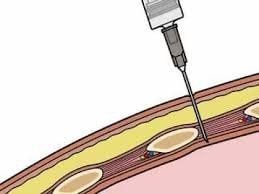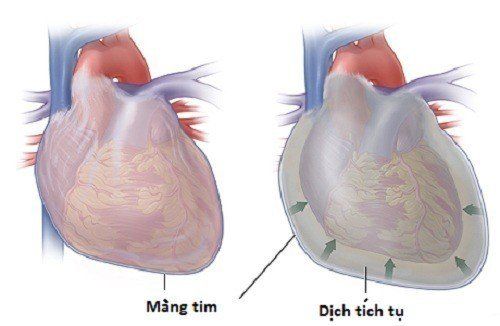This is an automatically translated article.
The article is professionally consulted by Master, Doctor Nguyen Le Duc Hoang - Emergency Medicine Doctor - Emergency Department - Vinmec Danang International General Hospital.Pericardial effusion puts pressure on the heart, requiring aspiration pericardial drainage to decompress and test the fluid. This is the only rescue method and needs to be done quickly.
1. What is cardiac tamponade by pericardial effusion?
Normally, the heart is surrounded by a sheath and creates a pericardial cavity. The pericardial cavity contains about 30-50ml of fluid, which helps to keep the heart in a stable position in the ribcage and helps the heart work smoothly, limiting friction.Pericardial effusion causing cardiac tamponade is a case where the chambers of the heart cannot expand, blood cannot flow to the heart and the heart does not squeeze effectively, which will lead to a drop in blood pressure, death if not treated promptly. . Pericardial effusion causing cardiac tamponade is a rare disease.
Compressing pericardial effusion is a sign of an inflammatory response and can occur when the outflow of pericardial fluid is blocked or when blood accumulates.

Máu không lưu thông được tới tim dễ dẫn tới tụt huyết áp
2. Causes and signs of pericardial effusion
Pericardial effusion causing the heart to be compressed can be caused by many reasons as follows:Inflammation caused by bacteria and viruses; Heart failure, complicated myocardial infarction, Some diseases such as hypothyroidism, lupus erythematosus, rheumatoid arthritis, scleroderma, Metastatic cancer (lung cancer, breast cancer, melanoma, cancer) pericardial or cardiac cancer,... Radiation therapy for cancer patients if the heart is in the radiation area, chemotherapy for cancer treatment Signs of pericardial effusion usually include:
Chest pain behind the bones chest pain, when taking a deep breath, pain will increase, Shortness of breath, low blood pressure, stroke, death if the amount of fluid is too much , feeling anxious.

Tràn dịch màng tim gây ra biểu hiện chóng mặt dễ ngất xỉu
3. Emergency pericardial effusion causing cardiac compression
In the emergency pericardial tamponade, the disease is often misdiagnosed with myocardial infarction, aortic dissection, or pulmonary disease.When pericardial effusion causes the heart to compress, aspiration pericardial drainage is required to decompress and test the fluid. This method needs to be done quickly. Steps to take:
Step 1: Prepare first aid equipment, ready at hand. Place an intravenous line in the patient. Set up a monitor Step 2: Anesthetize the sedated patient. Atropin injection for the patient; ultrasound examination before aspiration; put a nasogastric tube in case of gastric distention; Sterilize the puncture site and anesthetize the puncture site. Step 3: Poke at an angle of 30-45°, close to the tip of the sternum; poke towards the center of the left clavicle. Step 4: When the blood is aspirated without clotting, check if the needle tip is in the pericardial cavity by injecting a contrast solution for bronchoscopy. Step 5: Thread the wire, then expand the path to insert the tube to drain the pericardial fluid.

Chọc hút giải áp và xét nghiệm dịch màng ngoài tim
Master - Doctor Cao Thanh Tam has many years of experience in diagnosing and treating cardiovascular diseases; Performing transthoracic echocardiography in the field of internal medicine and interventional Cardiology; Perform other non-invasive functional investigations in the diagnosis and treatment of cardiovascular diseases. Currently working as a cardiologist at Vinmec Central Park International General Hospital since November 2015.
To register for cardiovascular screening at Vinmec, you can contact Vinmec Health System nationwide or register online HERE.
MORE
Diagnosis and treatment of acute pericarditis Basic echocardiography: What you need to know Normal pulse rate by age














